Monthly Retainers vs. Project-Based Proposals: Which is Best for Freelancers?
Freelancer dilemma: Monthly retainers or project gigs? See which model offers more stability, income, and freedom.
— Propoze
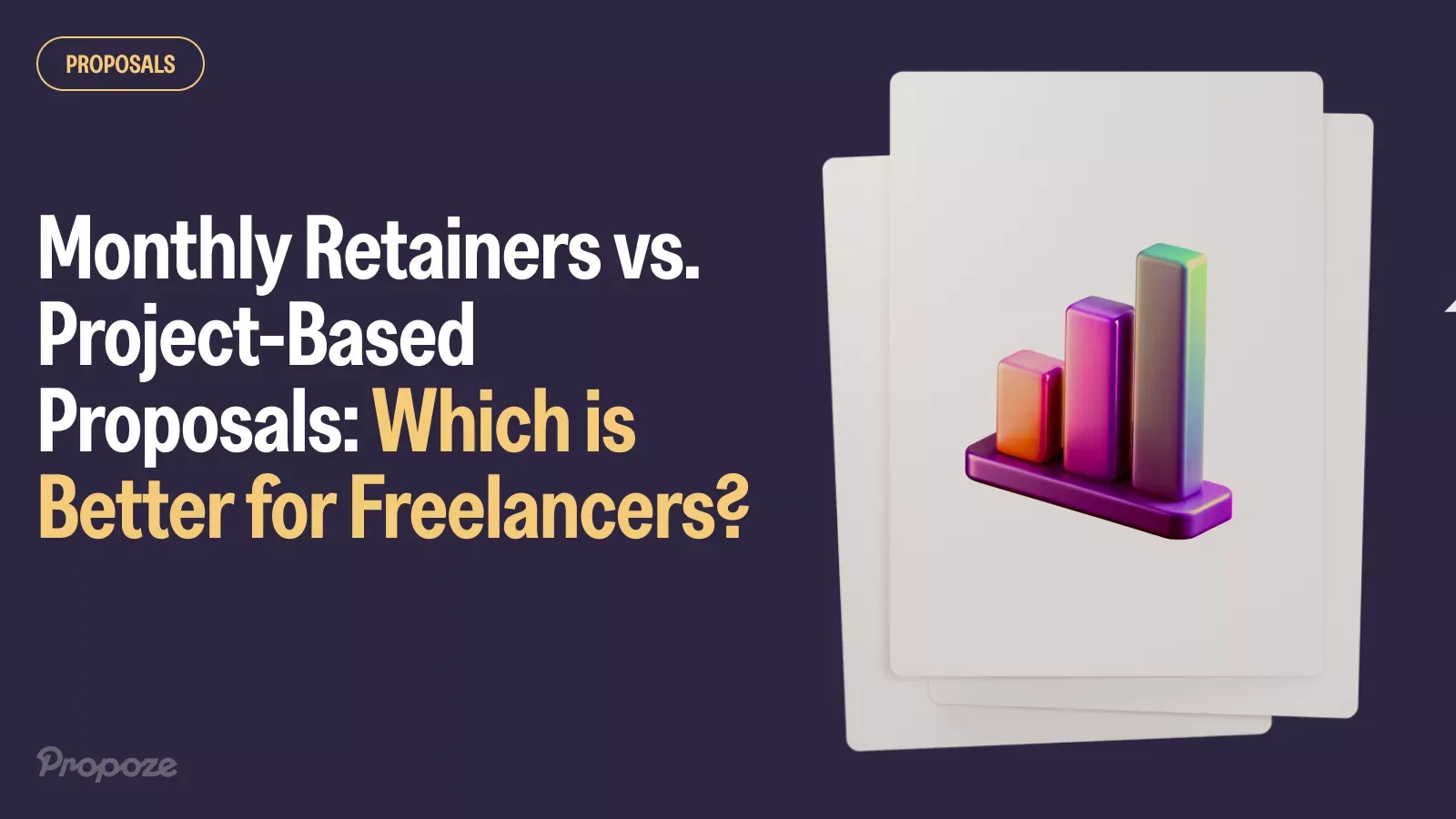
Monthly retainers vs. project-based proposals — which one should you choose as a freelancer?
It’s a tough call, right? Both pricing models can shape your income, client relationships, and the way you run your business.
Whether you prefer consistency or freedom, finding the right balance is important.
We’ll break down the pros and cons of each option so you can confidently pick what works best for you.
Let’s jump in!
The retainer model
The retainer model offers a structured approach to client relationships, providing both stability and predictability. For freelancers and agencies, this model ensures a steady cash flow, allowing for better financial planning and resource allocation.
Clients benefit from having a dedicated service provider who understands their ongoing needs and can deliver consistent results.
By adopting a retainer model, service providers can focus on delivering high-quality work without the constant pressure of finding new clients. This model fosters long-term partnerships, where both parties are on the same page regarding expectations and deliverables.
Whether you’re a marketing agency, a consultant, or a freelancer, the retainer model can be a game-changer in building a sustainable and profitable business.
Understanding retainer agreements
What is a retainer agreement?
A retainer agreement is a contract between a client and a service provider, such as a marketing agency, that outlines the terms of their working relationship.
In a retainer agreement, the client pays a recurring fee, known as a retainer fee, in exchange for access to the agency’s services for a specified period.
This type of agreement is commonly used in industries where ongoing services are required, such as marketing, law, and consulting.
Types of retainer agreements
There are several types of retainer agreements, each tailored to different needs and preferences:
- Pay-for-work retainer: This type of agreement stipulates a monthly rate that the client pays for the agency’s work. It’s ideal for clients who need a consistent amount of work done each month.
- Pay-for-access retainer: This agreement provides clients with access to an agency’s expertise for a flat fee. It’s perfect for clients who may not need regular work but want the assurance of having expert advice available when needed.
- Project-based retainer: Ideal for agencies that take on multiple projects and clients simultaneously, this agreement allows for flexibility in managing various tasks under a single retainer.
- Time-based retainer: This agreement outlines the number of hours of work an agency will perform each month. It’s great for clients who need a predictable amount of time dedicated to their projects.
- Lump sum retainer: A streamlined payment method where the client pays a lump sum upfront for a set period of services. This can simplify billing and ensure the agency’s commitment.
- Recurring retainer: This agreement specifies the number of hours over a set period, providing a recurring revenue model that benefits both the client and the service provider.
What is a monthly retainer? A quick overview
If you’ve been freelancing for a while, you’ve probably heard of monthly retainers.
They’re a popular option for freelancers looking to lock in steady, predictable income.
But what exactly is a monthly retainer, and why do so many professionals swear by it?

In short, it's an agreement where you’re paid a set fee every month for ongoing work.
If you want to learn more, we’ve got an in-depth guide on retainer agreements.
Why retainers work best for ongoing client needs
When a client needs ongoing support—like monthly deliverables or continuous updates—retainers are a win-win.
They give clients peace of mind knowing you’re available when needed, without renegotiating every time a task comes up.
For freelancers, it means steady income and the ability to plan your workload better, without constantly chasing new projects. Retainer projects help establish a clear scope of work and manage ongoing relationships effectively, ensuring expectations and goals are well-defined.
It’s perfect for building deeper, long-term relationships, where you can focus on quality rather than rushing through one-off jobs.
Plus, with a retainer, you become a trusted partner in your client’s long-term success!
Common challenges freelancers face with retainer agreements
While retainers can provide stability, they’re not without their challenges.
Here are the most common issues freelancers face:
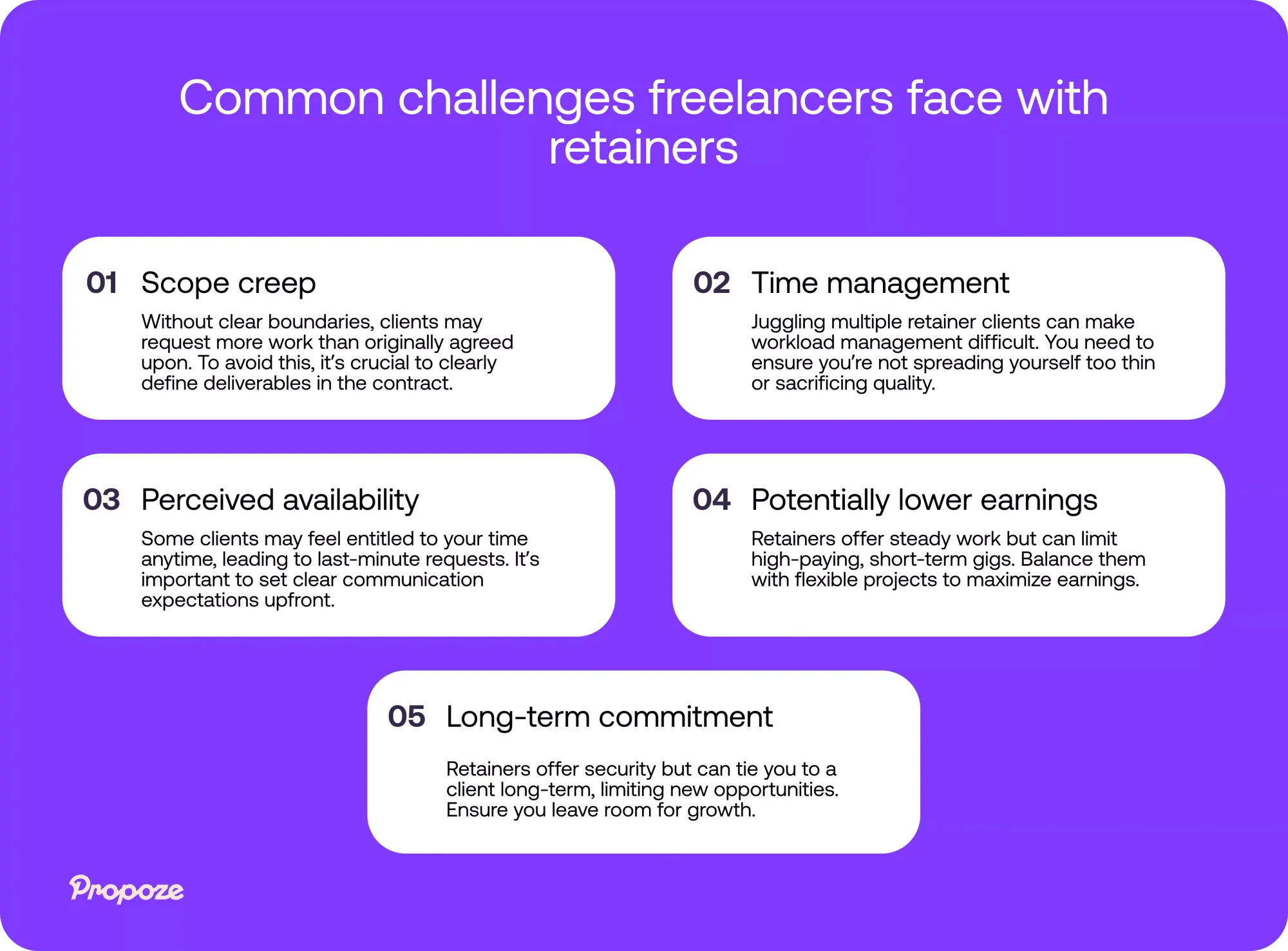
By addressing these challenges proactively—through solid contracts, time management, and setting clear expectations—you can maximize the benefits while minimizing the downsides.
Project-based pricing
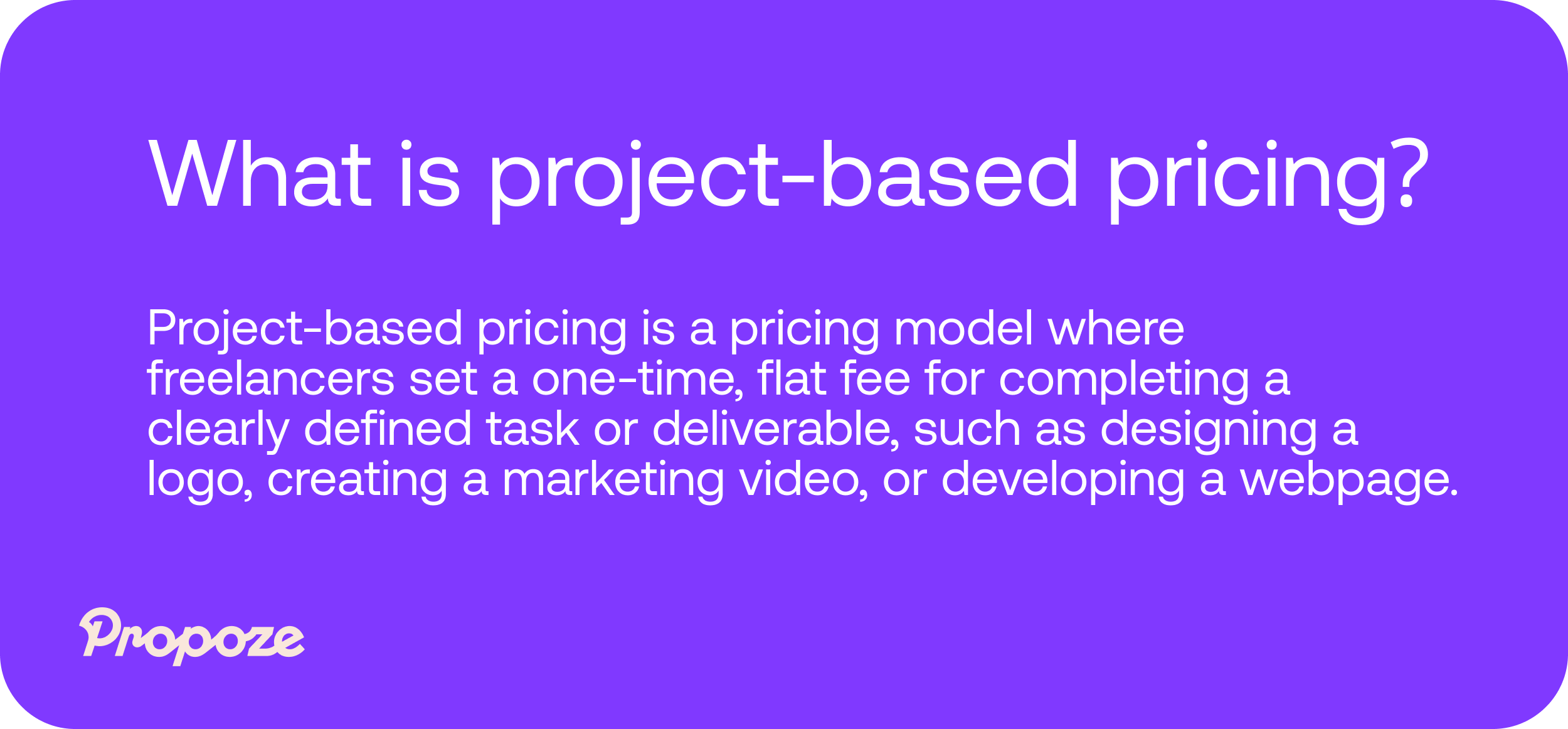
This project based pricing model is great for freelancers who prefer flexibility, allowing them to take on varied projects without long-term commitments.
Here’s an example.
Let’s say you’re a graphic designer, and a client hires you to create a website logo.
You agree on a price, deliver the final logo, and once the project is complete, you get paid. This fixed price approach simplifies billing and sets clear budget expectations for the client. Unlike retainers, there’s no ongoing relationship unless the client needs more work.
The main advantage?
You can often charge more per project compared to retainers.
But the downside is the unpredictable nature of the work—it’s feast or famine if you’re not actively finding new clients.
Project flexibility: Freedom or instability?
One of the biggest perks of a project based pricing structure is freedom—you can pick and choose the projects that interest you, set your own deadlines, and work with a wide variety of clients.
You’re not tied down by long-term contracts, allowing you to explore different industries and expand your skills. But with that freedom comes instability.
Unlike retainers, you can’t always predict when your next paycheck will come, which means you may face dry spells between projects.
For some freelancers, this unpredictability is a fair trade for flexibility.
Some may find the uncertainty of income stressful. It really comes down to whether you enjoy a fast-paced, changing environment or prefer the stability of steady work.
Client acquisition and revenue gaps with projects
With project-based work, finding clients can be a constant hustle. For instance, as a freelance web developer, you might finish a website and get paid, but without a new project lined up, the income only lasts so long.
This means you’re regularly searching for work, pitching, and negotiating—often without guaranteed results.
These gaps between clients can lead to revenue dips; spending weeks on proposals without a win means no income, adding financial pressure.
While some freelancers thrive on this variety, others find it stressful.
The key to success?
Keeping a steady pipeline of leads and lining up the next project before wrapping up the current one.

Retainers vs. project work: Which model is right for you?
Choosing between monthly retainers and project-based work depends on what you value most in your freelance career.
Retainers offer stability and consistent income, ideal if you want to build long-term client relationships and focus on steady work.
They’re perfect if you prefer structure and predictability in your workload. Agency services often customize agreements to meet client needs, whether through project-based fees for specific deliverables or retainer agreements for ongoing services.
In contrast, project-based work offers freedom and flexibility. You can work on diverse projects, set your own terms, and avoid being locked into long-term commitments.
However, this comes with the risk of inconsistent income and constant client hunting.
Ask yourself:
- Do you prefer reliable, recurring income, or do you thrive on variety and flexibility?
- Are you looking to build long-term partnerships or tackle quick, exciting projects? For a new client, agencies should prepare and manage relationships by customizing agreements and addressing specific needs, particularly when deciding between different pricing structures like retainer or project-based fees.
If you value security and the chance to focus deeply on a client’s goals, retainers are your best bet. But if you’re excited by new challenges and enjoy the hustle of acquiring new clients, project-based work might be the right fit.
Often, the most successful freelancers find a balance, combining retainers for financial stability while taking on project-based work to stay creatively energized.
When retainers offer more stability for cash flow
Take a freelance designer who transitioned from one-off design projects to a monthly retainer with a marketing agency.
Instead of hunting for new clients every month, the agency retained them for ongoing design work.
Another example is a freelance writer who partnered with a growing startup. The company needed ongoing content creation—blogs, social media posts, email campaigns—and didn’t want to deal with separate contracts for every deliverable.
Maximizing profit with project based work
For freelancers seeking to maximize profit, project-based work can be a powerful strategy.
These short-term commitments often allow freelancers to charge premium rates for specific tasks, especially when they bring niche expertise to the table.
Here are some examples.
A web developer may take on a project to build an entire website. The upfront pricing for this type of work can be significantly higher than what they might earn through ongoing retainer tasks.
Similarly, a freelance videographer might take on a specific project to shoot and edit a company’s product video.
This type of project allows them to focus intensely on one high-ticket deliverable, with the freedom to move on to another high-paying gig once it’s complete.
To succeed with project-based pricing, it’s essential to build a strong pipeline of clients and continuously market your services.
Income stability vs. flexibility: Key financial considerations
When deciding between retainers and project-based work, the biggest financial factor comes down to stability vs. flexibility.
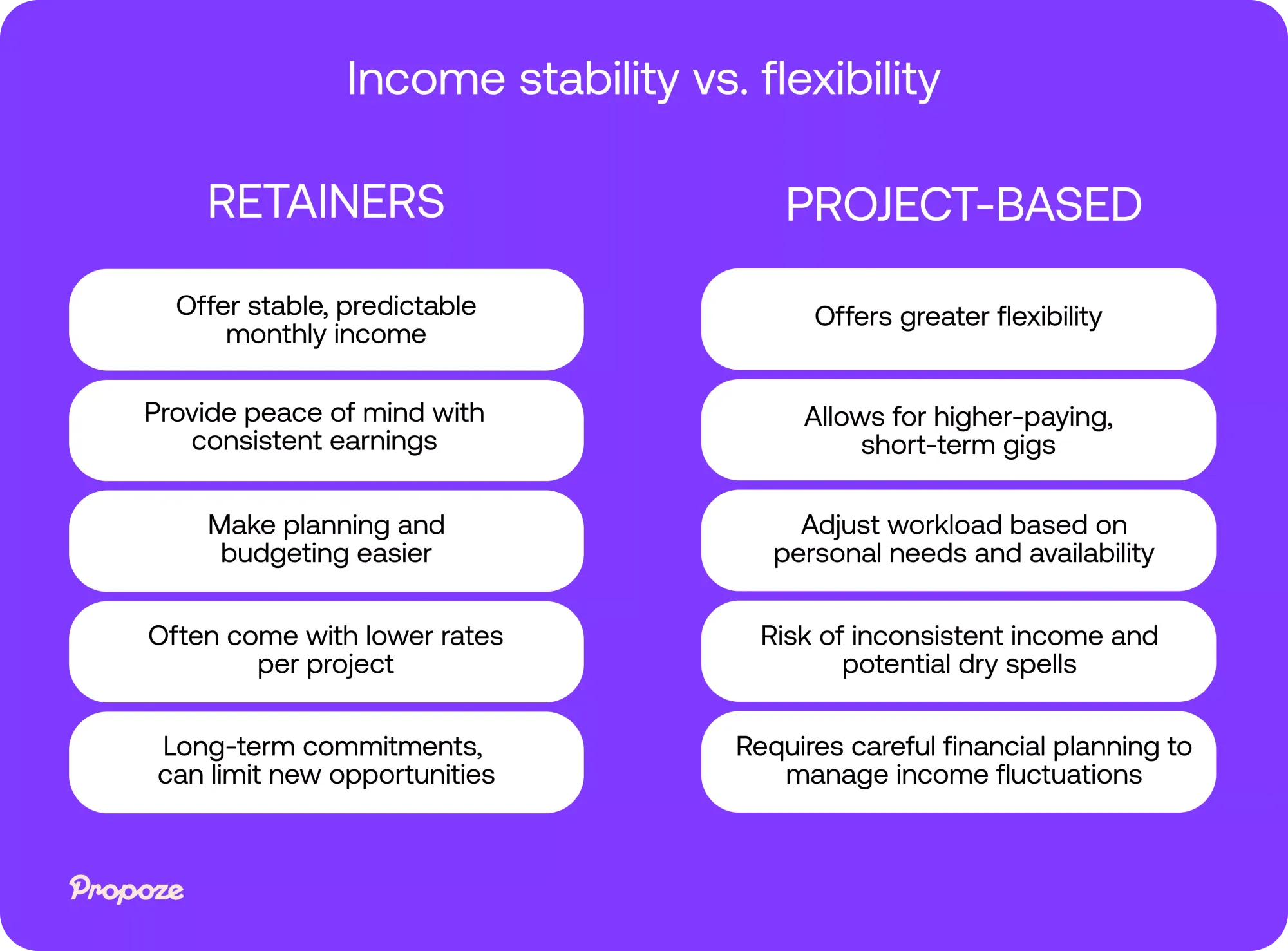
How to transition clients from projects to retainers successfully
Why transition clients from project work to retainers?
Simple: retainers bring consistency. Instead of constantly chasing new projects and wondering where the next gig is coming from, you get a steady, predictable income.
Start by identifying clients who require regular, repeatable work—whether it’s monthly reports, maintenance, or content creation.
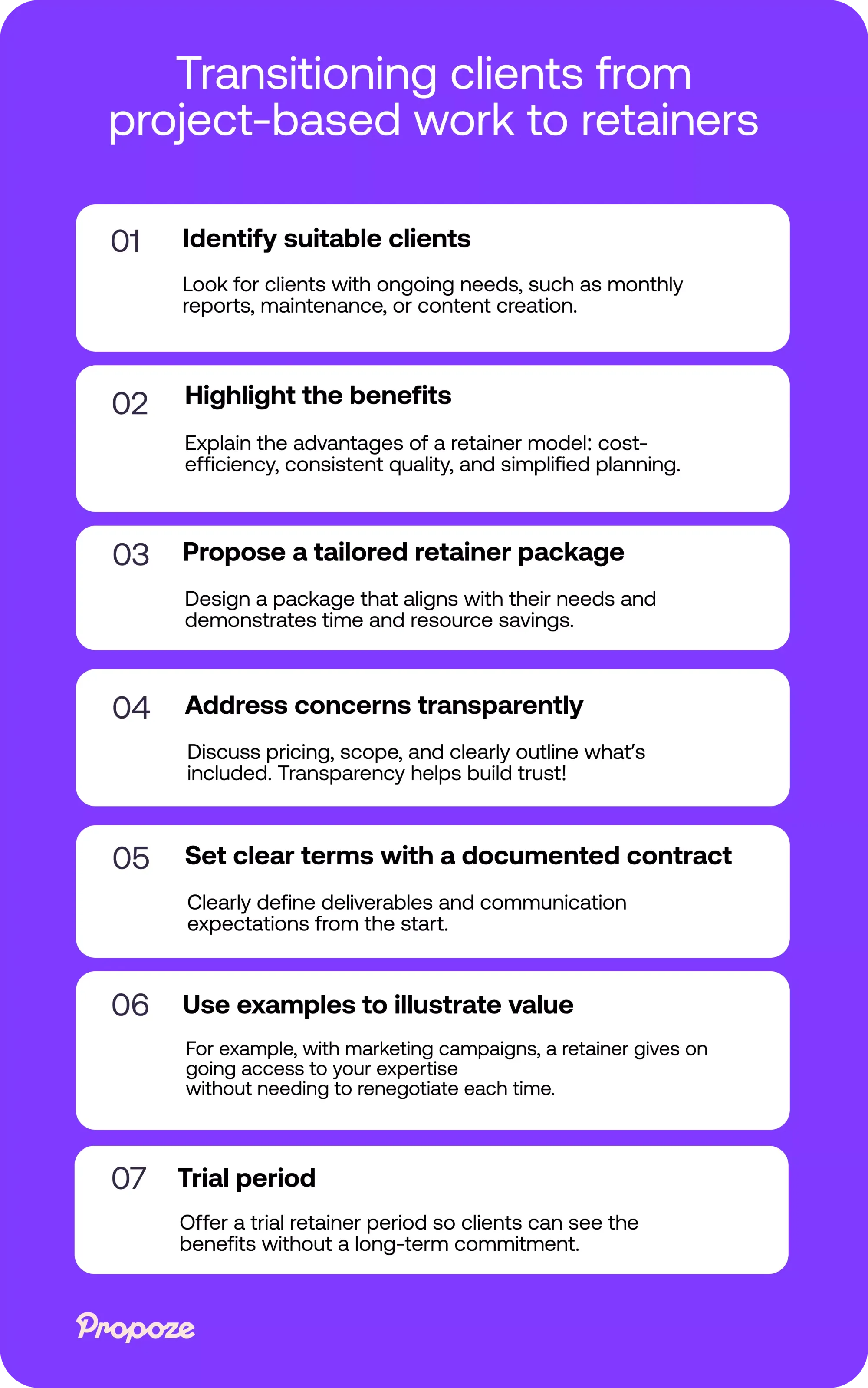
Pricing strategies for freelancers: Maximize revenue in retainers and projects
Maximizing your revenue as a freelancer comes down to smart pricing. Whether you prefer retainers or project-based work, setting your rates strategically ensures you’re compensated for your true value.
Here are some actionable tips to help you price effectively and boost your earnings, no matter the model you choose.
1. Know your worth:
Whether it's a retainer or project, always base your pricing on the value you provide, not just the hours worked.
For example, if your expertise directly boosts a client’s business, reflect that in your pricing.
2. Flat vs. hourly rates:
Retainers often benefit from flat-rate pricing. This ensures you’re not penalized for working efficiently.
For project-based work, an hourly rate can work well if the scope is unclear, but flat fees typically allow for more control and better profit margins.
3. Tiered retainer packages:
Offer tiered packages for retainers—basic, mid-level, and premium. Each tier should provide different levels of service, allowing clients to choose what fits their needs while maximizing your potential revenue from those who want premium services.
4. Upsell add-ons:
With retainers, you can offer optional add-ons for clients who may need extra work. By clearly defining the core retainer services, you can charge for additional tasks like extra revisions, special reports, or additional consulting hours.
5. Charge by project value:
For projects, the price is based on the value you’re bringing to the client. For example, if you’re designing a website that will bring in new leads or sales, price it according to its potential impact—not just your time spent.
6. Build long-term incentives:
For clients considering a retainer, offer discount or additional services for longer-term agreements (e.g., 6-month or 12-month contracts). This locks in stable revenue while rewarding the client’s commitment.
7. Review and adjust:
Routinely review your rates. If your skills, demand, or the market change, increase your prices accordingly. Don’t be afraid to renegotiate retainer fees if the scope of work increases over time.
Retainer pricing: Hourly vs. value-based models
When pricing retainers, freelancers generally choose between hourly and value-based models:
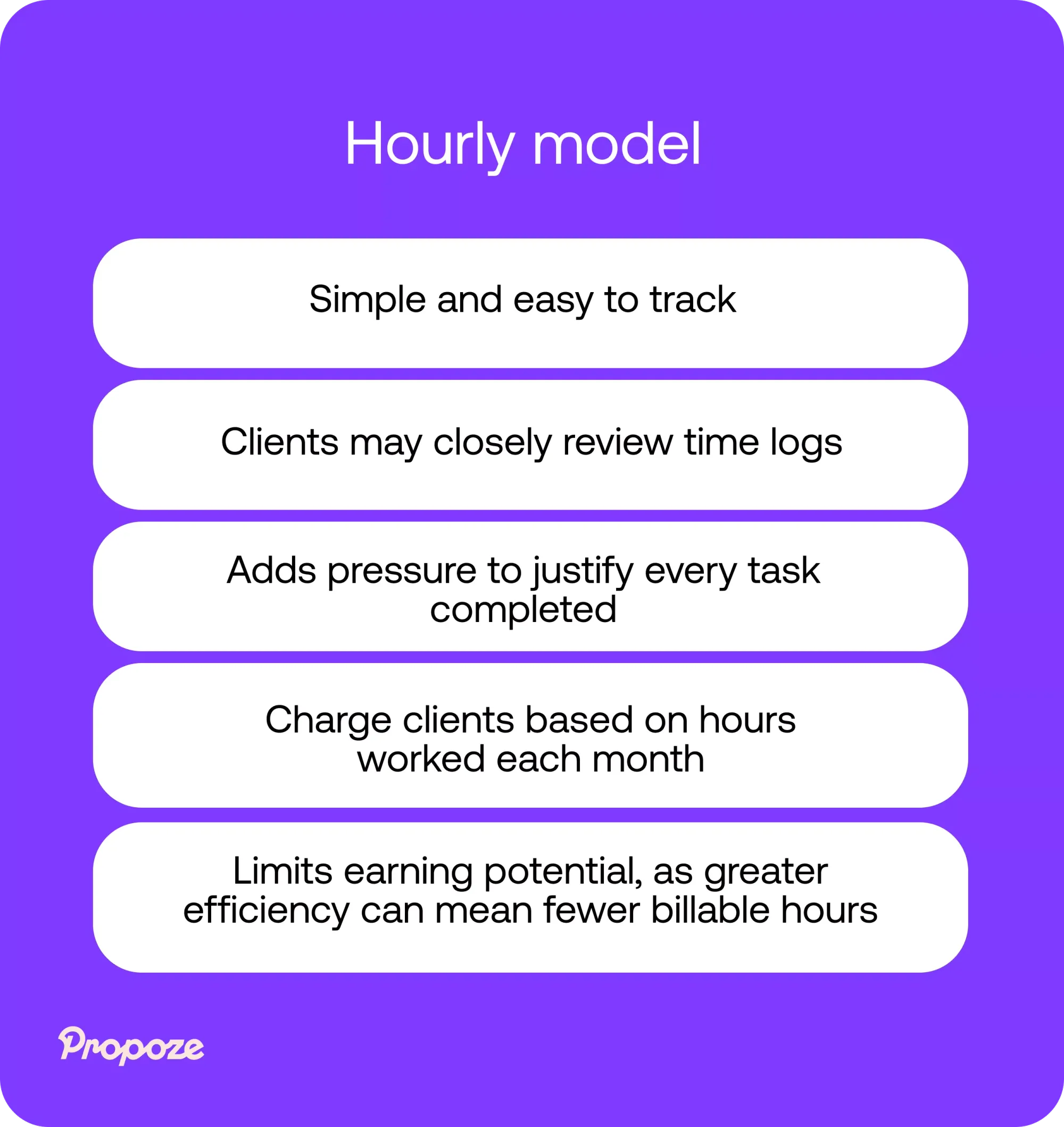
Hourly works for tasks with a clear time commitment, like administrative or ongoing maintenance.
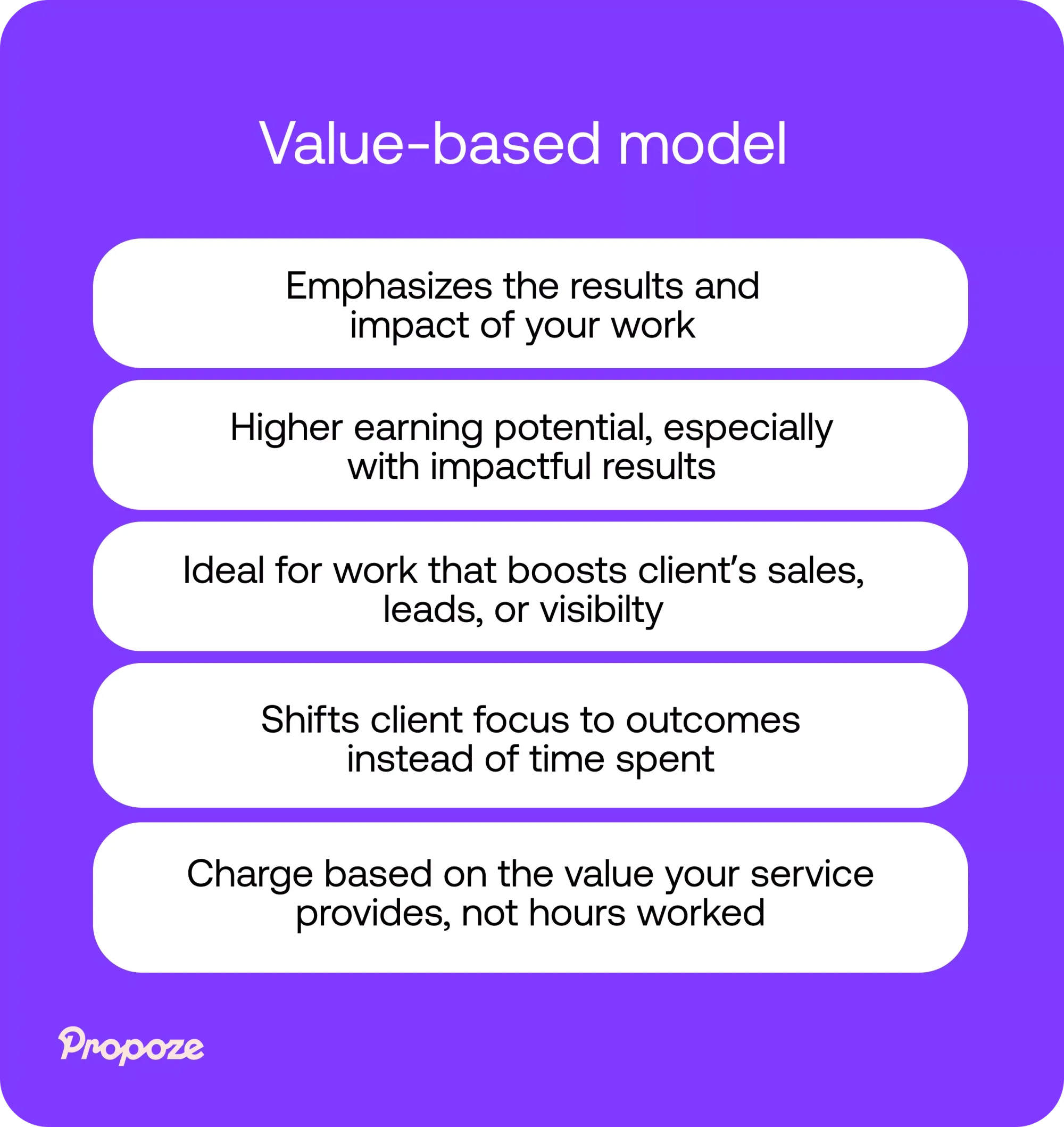
Value-based is better for services tied to business growth, such as marketing or strategy consulting, where your expertise delivers measurable results.
It allows you to charge more for high-impact work and aligns your interests with your client’s success.
Flat-rate pricing for projects: Pros and cons
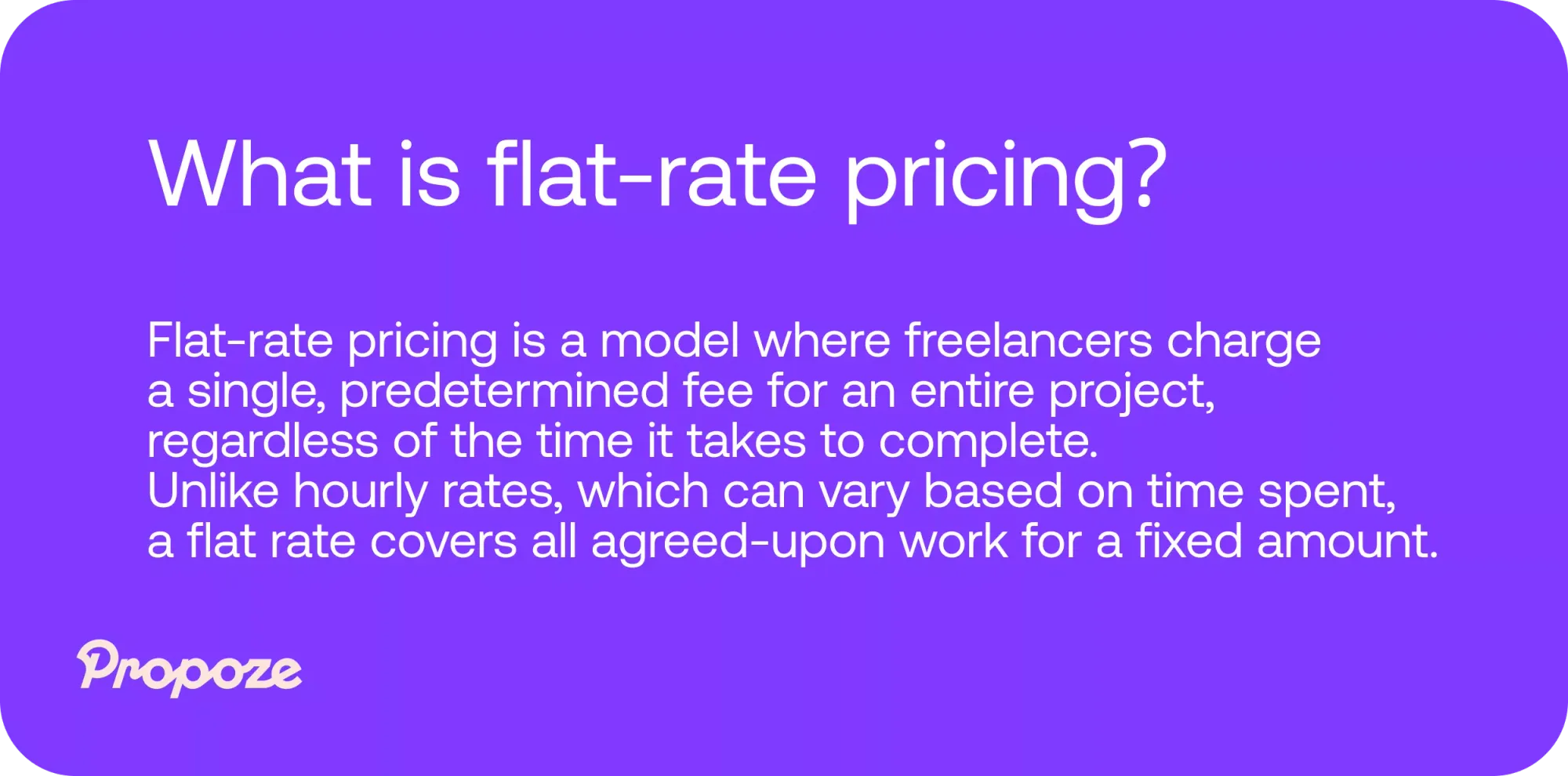
Flat-rate pricing is a great option for freelancers when the scope of a project is well-defined, and both parties clearly understand the deliverables.
Here’s a breakdown of the pros and cons:
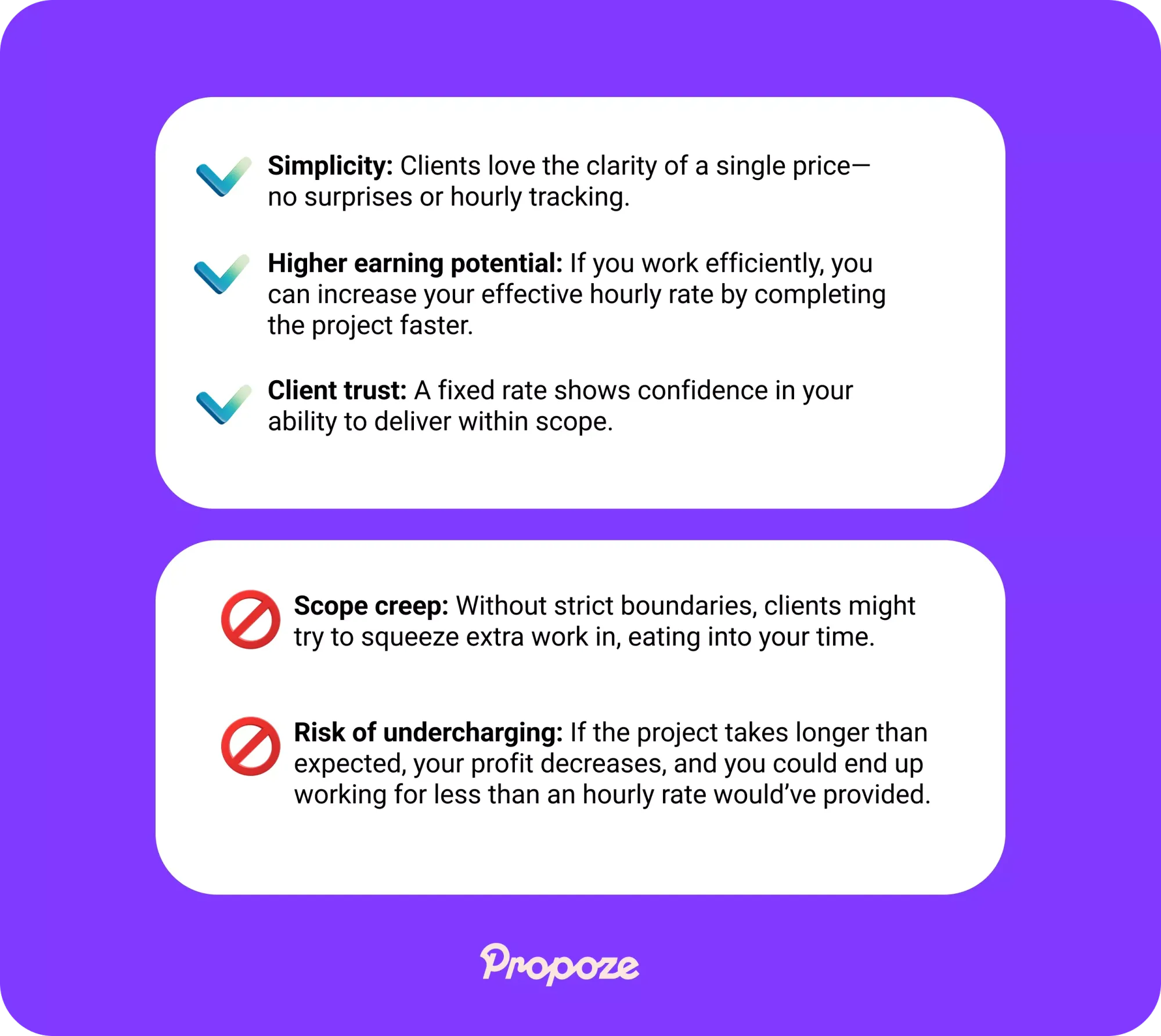
When to use it? Charge flat rates for projects with clear deliverables and timelines, like designing a website or writing a whitepaper.
It’s perfect when the work’s scope is unlikely to change, allowing you to manage your time and costs effectively.
Blending retainers and project work for maximum flexibility
Why choose between stability and flexibility when you can have both?
Blending retainers and project work allows freelancers to enjoy consistent income from retainers while taking on high-impact, short-term projects to boost earnings.
With Propoze, you can easily manage both models.
Propoze helps you create, send, and manage proposals for both retainer clients and project-based work—allowing you to maximize your income potential, keep clients happy, and streamline your workflow.
Try Propoze today with our free trial!
